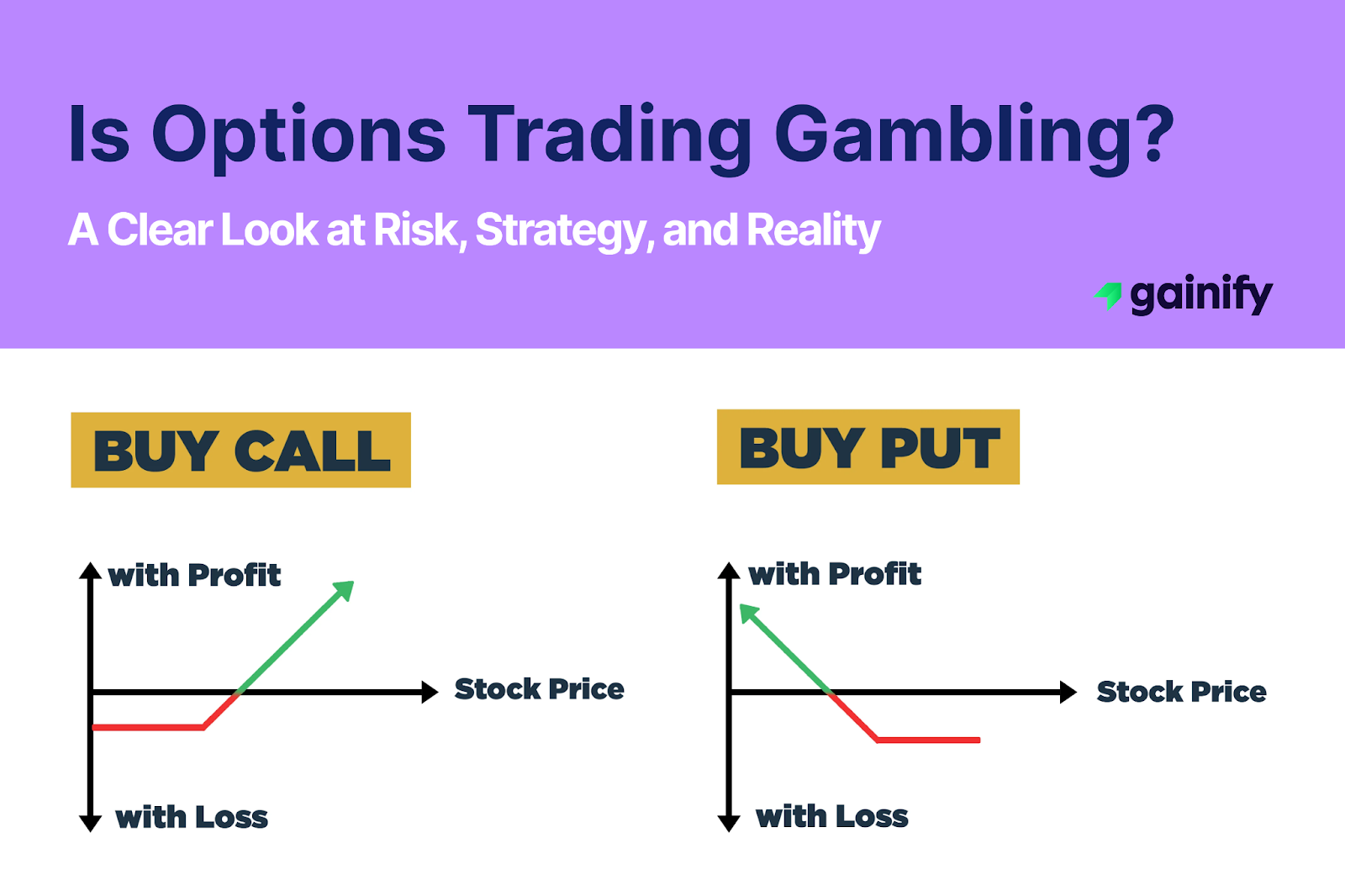Options trading is gaining attention among both new and experienced investors. You’ll see it mentioned across social media, trading apps, and financial news. Quick gains and dramatic losses make for exciting headlines, and they raise a fair question: is options trading just another form of gambling?
It’s a valid concern. When you buy an option, you’re paying for the right to bet on whether a stock will rise or fall by a certain date. You put in a small amount of money upfront and hope the market moves your way. At first glance, it can feel like placing a wager. But that’s not how options were designed. They are structured financial tools with clear rules, defined outcomes, and built-in risk controls.
When used properly, options can help manage risk, support long-term investing goals, or generate income. Without a clear plan, though, they can lead to emotional decisions and steep losses. The difference lies in the mindset, preparation, and structure behind each trade.
In this article, you’ll learn what options really are, how they work, and what makes them either smart tools or risky bets. We’ll define important terms like put option, call option, and strike price, explore real-world trading strategies, and highlight signs that a trade may be heading in the wrong direction. You’ll also get simple tips for building a safer approach – whether you’re new to options or looking to improve your existing strategy.
What Are Options and How Do They Work?
Options are contracts that give you the right but not the obligation to buy or sell a stock at a specific price before a set expiration date. The two basic types are:
- Call Option: Gives you the right to buy a stock at a certain price (called the strike price) by the expiration date
- Put Option: Gives you the right to sell a stock at a certain price by the expiration date
Every option is linked to something called an underlying asset, usually a stock, exchange-traded fund (ETF), or index. When you buy an option, you pay a fee called a premium. You are not required to use the option, but if the stock moves in the direction you expected, you can either sell the contract or exercise it to capture profit. If it moves the opposite way, your maximum loss is limited to the premium you paid.
In addition to buying options, traders can also sell options. This is known as writing options. When you sell a call or put, you collect the premium upfront but take on the obligation to fulfill the contract if the buyer decides to exercise it. Selling options can be part of income-generating strategies like covered calls or cash-secured puts, but it carries different risks and requirements, especially around margin.
To estimate an option’s fair value, many traders and market makers use pricing models such as the Black-Scholes model. These tools take into account time until expiration, volatility, interest rates, and the current price of the underlying asset to help guide decision-making.
Why Options Trading Can Look Like Gambling
Some people use options without understanding how they work. They buy weekly options with no clear plan, hoping for a quick jump in price. They may base trades on trends, social media posts, or gut feeling.
Examples of gambling-style behavior include:
- Buying calls or puts right before earnings
- Placing all capital in one short-term trade
- Trading without knowing maximum profit/loss
- Ignoring breakeven percentage, fees, or expiration dates
This kind of approach lacks structure. It turns a structured tool into a guessing game, especially when there’s no clear exit plan or stop-loss strategy in place.
How Strategic Options Traders Think Differently
Professional traders, financial advisors, and long-term investors approach options with clear planning. They use these instruments to serve specific purposes within a broader investment strategy. For example, some investors buy options to protect their stock holdings during uncertain times. Others use them to create income, often by selling covered calls or writing cash-secured puts on companies they already own or would like to own at a lower price.
These strategies are not random. They are grounded in structured thinking. Traders rely on a combination of tools and analysis, including:
- Multi-layered fundamental analysis, including free cash flow projections, forward earnings estimates, sector-relative valuation, and management effectiveness scores
- Technical timing models that incorporate moving averages, RSI (relative strength index), MACD crossovers, and volume profile to refine entries and exits
- Predefined exit protocols, such as conditional stop-loss orders, time-based exits, and volatility-adjusted trailing stops
- Portfolio-level risk controls, including trade size based on notional value, delta exposure management, and expected drawdown limits
- Macroeconomic and sector research, using economic indicators, interest rate outlooks, inflation reports, and sector rotation models
These investors often use checklists or written trade plans. They make sure each position fits their overall portfolio. If the trade does not meet their criteria, they do not take it. Each step is intentional.
They also focus on behavior. Successful traders do not rely on instincts or quick reactions. Instead, they track their decisions, evaluate results, and look for ways to improve. Their aim is not perfection. It is consistency and control over outcomes. Over time, this method creates a stable and informed approach to options trading.
Understanding the Real Risk
All investments carry some level of risk, and options trading is no exception. What makes options unique is that the potential loss and gain can often be calculated before the trade is even placed. This feature gives investors the ability to define risk, which is not always possible with individual stocks or other asset classes.
For example, when buying an option, the most you can lose is the premium you paid. That fixed risk can be appealing, especially during times of uncertainty. Traders can also apply hedging strategies to reduce exposure and protect portfolios. One common approach is buying a put option as protection against a potential drop in the value of a stock you already own. This strategy works like insurance – it costs money up front but helps cushion downside risk.
Another example is selling a covered call, where you hold a stock and sell a call option against it to earn income. This approach helps generate returns from a stock you plan to hold anyway. It may limit some upside potential, but it can add a reliable income stream.
These kinds of strategies show that options can be used as tools to manage exposure. Investors focused on long-term investing often include options as part of a diversified portfolio alongside stocks and bonds. When used thoughtfully, options can help stabilize returns, reduce risk, and support a more flexible investment plan.
Warning Signs You’re Using Options the Wrong Way
If your options trading feels random or unpredictable, or if your losses are increasing without a clear explanation, it may be time to reassess your approach. Here are some common warning signs that suggest your strategy needs more structure:
- You do not understand key concepts of option trading
- You are not clear on the breakeven price for each trade
- You are entering trades without a stop-loss plan or downside protection
- You are placing large trades based on intuition or hope, not data
- You are not paying attention to market conditions, trend shifts, or volatility
- You are relying on social media, hot tips, or momentum chatter instead of research
These patterns often lead to poor outcomes. The lack of a consistent process can magnify mistakes, especially during binary events such as earnings announcements, central bank decisions, or geopolitical surprises. In fast-moving markets, trades that are not backed by a clear plan can quickly go wrong.
Avoiding these traps starts with awareness. The best way to improve is by using a structured trading plan, documenting each decision, and focusing on repeatable strategies that match your experience and risk tolerance.
What Smart Traders Always Do
Options trading is most effective when it is guided by structure, discipline, and a clear set of rules. Successful traders do not rely on luck or emotion. Instead, they follow a process that helps them manage risk and make informed decisions. Here are key practices that experienced options traders use consistently:
- Start with simple, well-defined strategies
Focus on foundational approaches such as covered calls, cash-secured puts, and vertical spreads. These strategies have limited risk and are easier to understand, making them suitable for building skill and confidence. - Upgrade your knowledge until you feel comfortable with the strategy
Before using any new options strategy, make sure you understand how it works in different market environments. Read books, watch tutorials, or test it with paper trading. Confidence comes from preparation. You should be able to explain the strategy and its risks clearly before using real capital. - Know your maximum potential loss before placing any trade
Before entering a position, calculate the total risk using trade analytics or basic formulas. This helps prevent surprise losses and keeps risk aligned with your account size and comfort level. - Use trades that have defined risk and known outcomes
Avoid open-ended risk exposures. Favor strategies where both profit potential and maximum loss are clearly measurable. This makes it easier to manage emotions and respond to market moves logically. - Choose reliable trading platforms with clear disclosures
=Use brokers and tools that offer full transparency, including detailed risk analysis, educational support, and access to simulated trading. Look for platforms regulated by credible agencies that meet high disclosure requirements. - Follow the rules and standards of recognized exchanges
Stick with contracts listed on regulated markets such as the Chicago Board of Options Exchange (CBOE). These exchanges enforce margin standards, reporting practices, and investor protections. - Make data-based decisions, not emotional ones
Build each trade on real analysis. Use financial reports, technical indicators, market indexes, and sector trends as inputs. Avoid reacting to price movements, news headlines, or hype without context. - Maintain a trading journal and review your results
Keep a detailed log of every trade, including the rationale, strategy, outcome, and what could be improved. Over time, this log becomes one of your most valuable tools for spotting patterns and strengthening your decision-making.
Skilled options traders focus on preparation and a repeatable process. Their success is not based on trying to predict the market perfectly. It comes from managing risk thoughtfully, adapting to changing conditions, and refining their strategy through experience and review.
FAQs: Common Questions About Options and Risk
Q: Can options be part of a safe investment strategy?
A: Yes. When used with proper risk controls, they can hedge against losses or earn steady income. Many long-term investors use them alongside stocks and bonds.
Q: Are options good for beginners?
A: They can be, if you start slow. Focus on learning, use small trades, and begin with risk-defined strategies. Avoid overtrading or reacting to social media.
Q: What’s the biggest risk in options trading?
A: Trading without understanding the risk profile. If you don’t know your potential loss or how an option behaves near expiration, it can hurt your account quickly.
Q: How can I improve my results with options?
A: Track your trades. Use both technical and fundamental analysis. Study market tops and bottoms, and review how options performed during each. Use stop-loss orders where appropriate.
Q: Are there rules or protections in place?
A: Yes. U.S. brokers follow regulations that include whistleblower protection, margin requirements, and investor education standards.
Options Require Thought, Not Luck
Options trading can be misunderstood. Some use it as a shortcut to fast profits, and for them it feels like gambling. But when used correctly, with planning and clear risk limits, options are tools that support better decisions.
They can help you manage exposure, reduce losses, and fine-tune strategies across many market environments. The key is learning how they work, applying smart rules, and staying focused on what matters most – protecting your capital and growing it over time.
Always trade with purpose. Understand the math. Build a process. That’s how real investors use options to their advantage.
Disclaimer: Options trading involves risk and is not suitable for every investor. Before trading options, review your financial goals, experience level, and risk tolerance. Always understand the terms of any strategy you use, and consult with a licensed financial advisor or registered broker when necessary. This article is for informational purposes only and does not constitute financial advice.




